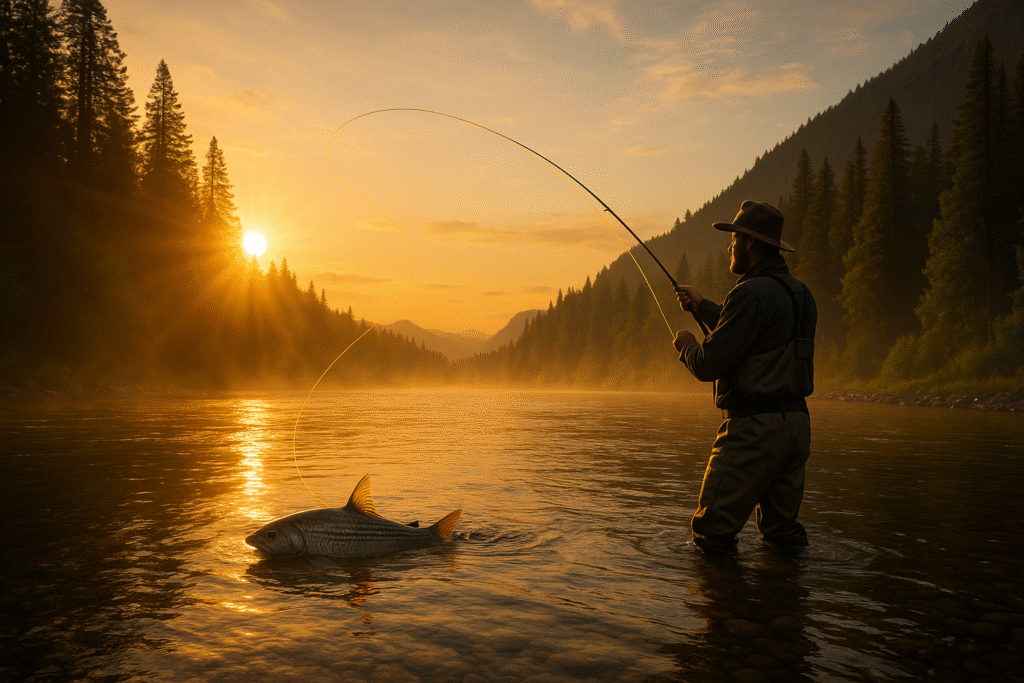Fly Fishing Holiday: Plan, Pack & Go (2025 Guide)
Why a Fly Fishing Holiday Belongs on Your Bucket List
A fly fishing holiday blends exploration with immersion.
It’s sunrise mist, precise casts, and the satisfying zip of a reel as a fish runs down-current.
Whether you crave quiet creeks or tropical flats, a well-planned trip maximizes fishing time, reduces stress, and helps you come home with memories—not mishaps.
Quick Planner — What This Guide Covers
You’ll get: season-by-season destinations, freshwater vs. saltwater choices, a compact gear strategy, a printable packing table, licensing must-knows, a real-world 5-day itinerary, budgets, logistics, safety, and photo tips.
Use the checklists, then book confidently.
Best Destinations by Season
Dial in your calendar first; the river (or flat) decides the rest.
Spring (Mar–May): Rockies, Iceland, Spain Pyrenees
- Rockies (CO/WY/MT): Skwala stones and blue-winged olives kickstart trout.
- Iceland: Ice-out char and browns with surreal backdrops.
- Pyrenees (Spain): Clear freestones, wild browns, and fewer crowds.
Summer (Jun–Aug): Montana, Alaska, British Columbia
- Montana: Prime hatches, dry-fly heaven.
- Alaska: Rainbows, salmon, and mouse patterns on freestone gems.
- BC: Bull trout, cutthroat, and glacier-fed wilderness.
Fall (Sep–Nov): Patagonia Spring, Scotland Salmon, New Zealand
- Patagonia (Oct–Nov): Southern-hemisphere spring means hungry trout.
- Scotland: Atlantic salmon runs and storied rivers.
- New Zealand (Oct–Apr): Sight-fishing to big, spooky browns begins.
Winter (Dec–Feb): Yucatán Saltwater, Seychelles, New Zealand
- Yucatán: Bonefish and baby tarpon on warm flats.
- Seychelles: Permit puzzles and GT mayhem (advanced).
- New Zealand: Peak trout season continues.
Freshwater vs. Saltwater: Choose Your Adventure
Pick your playground by your favorite puzzle.
Trout, Grayling & Salmon (Freshwater)
- Intimate reading of water, stealth, and drift.
- Waders, 4–6 wt rods, and match-the-hatch flies.
Bonefish, Tarpon & Permit (Saltwater)
- Sight-casting, wind management, and longer shots.
- 7–10 wt rods, tropical lines, and quick strip sets.
Matching Tactics, Tackle & Travel Logistics
Freshwater often means rental cars and short hikes. Saltwater tends to be skiffs, poling guides, and strong sun. Both reward fitness and good footwear.
Gear That Travels Well
Travel light; cast often.
Rod & Reel Pairings (2-Setup Strategy)
- Freshwater Duo: 5 wt (trout all-round) + 6 wt (wind/streamers).
- Saltwater Duo: 8 wt (bonefish) + 10 wt (tarpon/permit).
Use 4-piece travel rods in tube-length carry-on. Reels with sealed drags for salt.
Lines, Leaders, Tippet & Compact Fly Box
- One floating line per rod; optional sink-tip for streamers.
- Leaders: 9–12 ft (freshwater 4X–6X; salt 12–20 lb).
- Tippet spools that nest.
- Slim fly box with confidence patterns only.
Waders, Boots & Wet-Wading Kits
- Breathable chest waders + lightweight boots for spring/fall.
- Wet-wading (summer/tropics): quick-dry pants, gravel guards, amphibious shoes.
Packable Apparel & Care
- Sun hoodie, brim hat, buff, polarized lenses.
- Microfiber towel, biodegradable soap, hanger for nightly dry-outs.
| Item | Notes | Packed || -------------------------------- | ------------------------------- | ------ || 2 travel rods (5 wt & 6/8 wt) | 4-piece tubes fit overhead bins | ☐ || 2 reels + spare spools | Floating lines; spare backing | ☐ || Leaders & tippet | Fresh: 4X–6X; Salt: 12–20 lb | ☐ || Slim fly box | 20–30 patterns you trust | ☐ || Waders/boots or wet-wading shoes | Consider airline weight limits | ☐ || Sun hoodie, buff, brim hat | UPF preferred | ☐ || Polarized sunglasses | Amber/bronze for contrast | ☐ || Packable rain shell | Essential for mountains/tropics | ☐ || Small net & forceps | Barbless-ready | ☐ || Permits/license & ID | Digital + paper copies | ☐ || Dry bag & phone case | Boat days, rain | ☐ || First-aid & meds | Include blister care | ☐ |Conclusion — Tight Lines, Zero Stress
A rewarding fly fishing holiday is 80% planning and 20% luck. Pick your season first, match destination to your skill and style, travel light with a two-rod kit, respect local rules, and leave room for weather pivots. Do that—and every cast feels like a gift.
FAQs
Q1. What’s the best beginner-friendly fly fishing holiday?
Rockies summer or Montana late July–August for forgiving conditions, wading access, and plentiful dry-fly action.
Q2. Do I need a guide if I’m experienced?
Not always. But for saltwater flats, tides/wind/local knowledge make a guide day or two worth every dollar.
Q3. Can I bring fly rods as carry-on?
Usually yes. Keep rods in tubes, reels with lines are typically fine, and pack tools in checked luggage.
Q4. How many flies should I bring?
A slim box of 20–30 confidence patterns beats a suitcase full. Add a few local patterns from a nearby fly shop on arrival.
Q5. What if weather blows out my river?
Have backup waters (spring creeks, lakes) and all-weather flies (ants, streamers). Build in one flex day.
Mini “Hatch Heatmap” at a Glance (Table)
| Region / Month | Mar | Apr | May | Jun | Jul | Aug | Sep | Oct |
|---|---|---|---|---|---|---|---|---|
| Rockies Trout | ●● | ●●● | ●●● | ●● | ●● | ●● | ●●● | ●● |
| Iceland Trout/Char | ○ | ● | ●● | ●●● | ●●● | ●● | ○ | ○ |
| Montana Hoppers | ○ | ○ | ○ | ● | ●● | ●●● | ●●● | ● |
| Patagonia (Spring) | ○ | ○ | ○ | ○ | ○ | ○ | ○ | ●●● |
| Yucatán Bones/Tarpon | ●● | ●● | ●●● | ●●● | ●● | ●● | ●● | ●● |
(● = good, ●● = very good, ●●● = prime; not a regulation calendar.)










